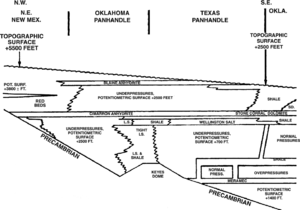Difference between revisions of "Regional pressure compartments"
Cwhitehurst (talk | contribs) |
Cwhitehurst (talk | contribs) |
||
| Line 46: | Line 46: | ||
[[file:formation-fluid-pressure-and-its-application_fig5-25.png|thumb|{{figure number|4}}Modified.]] | [[file:formation-fluid-pressure-and-its-application_fig5-25.png|thumb|{{figure number|4}}Modified.]] | ||
| − | Following is a pressure-depth plot of a well through the Anadarko regional pressure cornpartment. Fluid pressure goes from normal above the top seal to overpressured within the pressure compartment, then back to normal below the bottom seal. Many regional pressure compartments contain smaller subregional and local pressure compartments. Al-Shaieb et al.<ref name=ch05r2>Al-Shaieb, Z., Puckette, J., O., Abdalla, A., A., Ely, P., B., 1995b, [http://archives.datapages.com/data/specpubs/memoir61/ch05/0069.htm Three levels of compartmentation within the overpressured interval of the Anadarko basin], in Ortoleva, P., J., ed., Basin Compartments and Seals: AAPG Memoir 61, p. 69–83.</ref> use the following terms: | + | Following is a pressure-depth plot of a well through the Anadarko regional pressure cornpartment. Fluid pressure goes from normal above the top seal to overpressured within the pressure compartment, then back to normal below the bottom seal. Many regional pressure compartments contain smaller subregional and local pressure compartments. Al-Shaieb et al.<ref name=ch05r2>Al-Shaieb, Z., Puckette, J., O., Abdalla, A., A., Ely, P., B., 1995b, [http://archives.datapages.com/data/specpubs/memoir61/ch05/0069.htm Three levels of compartmentation within the overpressured interval of the Anadarko basin], in Ortoleva, P., J., ed., Basin Compartments and Seals: [http://store.aapg.org/detail.aspx?id=748 AAPG Memoir 61], p. 69–83.</ref> use the following terms: |
* Regional pressure compartments—first-order or mega-compartments | * Regional pressure compartments—first-order or mega-compartments | ||
Revision as of 16:02, 19 February 2014
| Exploring for Oil and Gas Traps | |

| |
| Series | Treatise in Petroleum Geology |
|---|---|
| Part | Critical elements of the petroleum system |
| Chapter | Formation fluid pressure and its application |
| Author | Edward A. Beaumont, Forrest Fiedler |
| Link | Web page |
| Store | AAPG Store |
Definition
Most deep sedimentary basins of the world contain a shallow, normally pressured hydraulic system overlying one or more hydraulic compartments whose pressures are above or below the normal static water pressure.[1] In this discussion these hydraulic compartments are called pressure compartments. They are defined within a basin from pressure measurements.
Seals
Seals isolate fluids within compartments from fluids that are in pressure communication with the surface (normally pressured hydraulic system). The top seal is more or less horizontal and usually cuts across stratigraphic units. It forms where authigenic minerals (usually calcite) fill the pore spaces. The bottom seal of regional compartments is usually a well defined lithostratigraphic unit. Commonly, the side seals are thin, mineralized zones paralleling vertical faults.
Pressure compartment recognition
Pressure compartments develop after the compartment has been sealed, isolating the fluids inside the compartment. Pressure in the compartment can be over, under, or normal. We can map a compartment's top, bottom, and sides from pressure measurements. Since pressure measurements are the main identifying criteria, the normally pressured compartments are usually not recognized.
Schematic of pressure compartment
The schematic cross section and pressure-depth plot in Figure 1 shows how changes in the fluid pressure gradient correlate with the top and bottom seals of a regional pressure compartment in a foreland basin.
Multiple pressure compartments
Many sedimentary basins contain two or more pressure compartments. The cross section in Figure 2 illustrates the multiple pressure compartments of the Anadarko basin.
Regional pressure compartment
The cross section in Figure 3 illustrates a regional pressure compartment from the Anadarko basin of Oklahoma.
Example: gradient profile
Following is a pressure-depth plot of a well through the Anadarko regional pressure cornpartment. Fluid pressure goes from normal above the top seal to overpressured within the pressure compartment, then back to normal below the bottom seal. Many regional pressure compartments contain smaller subregional and local pressure compartments. Al-Shaieb et al.[2] use the following terms:
- Regional pressure compartments—first-order or mega-compartments
- Subregional compartments—second-order compartments
- Local compartments—third-order compartments
The fluid pressure gradient variations within the pressure compartment on the plot in Figure 4 represent the smaller second- and third-order compartments.
See also
- Pressure compartments
- Subregional and local pressure compartments
- Pressure compartment seals
- Applying pressure compartment concepts to exploration
References
- ↑ Powley, D., E., 1990, Pressures and hydrogeology in petroleum basins: Earth Science Reviews, vol. 29, p. 215–226.
- ↑ Al-Shaieb, Z., Puckette, J., O., Abdalla, A., A., Ely, P., B., 1995b, Three levels of compartmentation within the overpressured interval of the Anadarko basin, in Ortoleva, P., J., ed., Basin Compartments and Seals: AAPG Memoir 61, p. 69–83.



